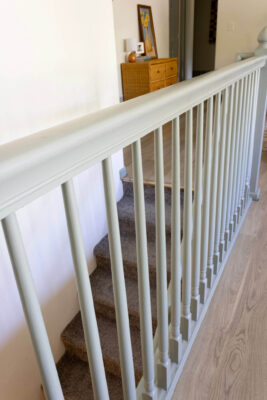Today I’m sharing how I scraped my popcorn ceilings for only $25! The whole step-by-step process for DIY cheap popcorn ceiling removal.

Our bathroom shower has been directing steam right onto the popcorn texture above it. It’s been cracking and peeling. The perfect excuse to learn how to remove the popcorn texture and repaint it, right? This project is manageable whether you’re renovating a new house before moving in, or if you’ve already been living in your home for a while. I did this all by myself, but if you can wrangle up help, it will go even faster.
Best part? You probably have all the tools you need already!
Tools & Materials Needed
Cheap Popcorn Ceiling Removal DIY Instructions
1. Empty the room
Remove as much furniture and decor as you can. This will make it easier to move the ladder around to reach every corner of the room without knocking something over.
2. Hang plastic sheeting
Next, hang plastic sheeting on every wall to protect them from dust and dirt. Use a single line of tape to seal out the dust and debris.
I recommend leaving a foot of space between the ceiling and the plastic sheeting. If you tape the sheet right in the corner of the wall and ceiling, the tape might get wet and fall down. The dust, dirt, and texture you’ll be scraping off the ceiling will get the walls dirty. Just be aware that you may need to clean or repaint the exposed parts of the wall.
Overlap the seams on the plastic sheets for extra protection. Add a layer (or two) of plastic sheeting to the floor. Make sure the sheets hanging from the walls lays on top of the sheeting on the floor. This layering will protect your floors better! Tape the seams as needed.
Tip: The texture debris is heavier than you think! Make sure your tape is strong enough to hold the plastic sheeting up. The weight of the scraped texture may pull it down. This tape option did the trick for me.

3. Put On Protective Gear
I skipped this step, and it was a major mistake. I woke up to swollen eyes and a tight throat because I let 30 years of dust rain down on me during this project! Wear goggles or protective glasses, and a dust mask. You don’t want to breath in all that paint and drywall material.

Tip: Get your ceiling tested for asbestos if your home was built in the 1980’s or earlier. Use a home test kit like this. If it comes back positive, hire a pro to come remove it or cover it up with shiplap, tongue and groove, or bead-board instead. This is a more costly option but it’s much safer.
4. Spray the Popcorn Texture With Water
Next, spray a 4′ x 4′ area with water using a spray bottle or garden pump. Work in small sections so it doesn’t start to dry out. I suggest doing a moderate to light spray, so you don’t damage the drywall underneath. I used a $0.99 spray bottle from Target, and it worked great.
Let the water sit for 5-10 minutes. If you try scraping it right away, it will create a lot more dust and leave behind texture that you’ll have to sand off later. Trust me, let it soak! It’s so much easier when wet.

5. Scrape Away, Baby! Goodbye popcorn texture.
Once the texture is soft, use your putty knife or removal tool at a straight, horizontal angle to scrape the texture off. Try not to gouge the drywall underneath as best you can. Scrapes and dings in the drywall are inevitable, but do your best to keep it smooth. Imperfections will need to be filled in later.

Pay close attention to your corners. You may need to score them with a razor blade to create a clean line between the ceiling and the wall paint/texture. My ceiling had been painted about 1″ all the way around which made it harder to remove the popcorn texture at the edge.
6. Clean Up
Once all the texture is down, carefully clean up. Remove all the plastic sheeting, painters tape, and dust and vacuum as needed. Your ceiling will look something like this (below), and you’re ready for the next step: drywall finishing!

What’s Next After Removing The Popcorn Texture?
After completing this project, we encountered a roof leak right above our shower. It took us some time to diagnose and repair. Ultimately we decided to finish the ceiling with shiplap instead of paint. We needed a large drywall repair, and I found drywalling really challenging to DIY. The cost of hiring a painter to finish this project was about the same as just adding shiplap ourselves. Our cheap popcorn ceiling removal suddenly felt very expensive, but we had to finish it.
Here are the general steps you need paint your ceiling after removing the popcorn texture.
Finishing the Drywall & Painting
1. Touch Up The Drywall After Popcorn Ceiling Removal
After scraping the popcorn texture off, you can fill in any nicks, dings, and scrapes with drywall compound as needed. Make sure there’s no drywall tape showing. Sand the drywall smooth as needed. If needed, hire someone skilled in drywall to add these finishing touches.
2. Prime With Drywall Primer
Next, prime with drywall primer. This is a specific type of primer that seals and protects the unfinished drywall. It also allows your paint to adhere correctly. Without this, you can damage your drywall, and your paint finish will look splotchy.
3. Add paint!
Finally, add your paint! You may need a few coats to cover this unfinished drywall.
And you’re done!! Removing popcorn ceiling texture is one of the best updates you can do in your home. Whether you DIY this project or hire it out, the investment is so worth it. It makes your space feel cleaner and more modern.
Best of luck on this project!






